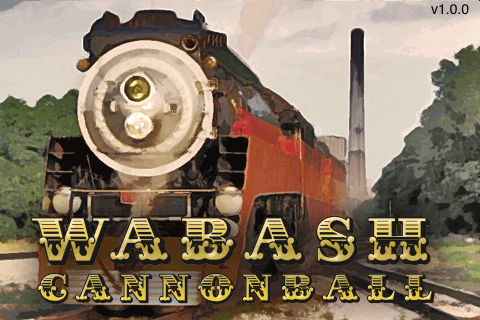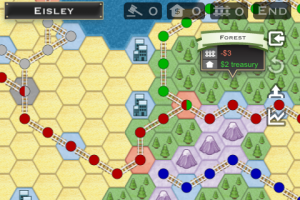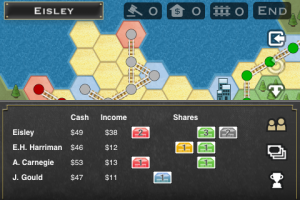Review Wabash Cannonball (iPhone)
Posted by James (admin) on October 2nd, 2010
Like me, you may know Wabash Cannonball as Chicago Express as that’s the name under which it was released by Queen Games. For this review, I’ll refer to the game as Wabash Cannonball as that’s the name of the iPhone app and the original game, but the games are (as far as I’m aware) the same.
 THE GAME
THE GAME
During the game, the players develop railroad networks in America. Different to many games, players don’t own a single railroad company but, instead, can buy shares in any of the railroads and earn money from dividends. Going clockwise, players take an action to either start an auction for a share in a railroad, extend a railroad (in which they own shares) by 3 pieces of track, or develop a space. Each round, there are 3 auction, 4 development and 5 lay track actions available. When two of these three action types have all been used, the round ends and dividends are paid to railroad shareholders. The dividend paid per share is the railroad’s value (based on the spaces it runs through) divided by the current number of shares owned.
Laying track extends a railroad’s network and increases its value; however, this costs money. A great game mechanic is that the money paid for shares goes into that railroad’s treasury and it is this money that is used to lay track. Any railroad reaching Chicago earns its shareholders a special dividend. Developing mountain and city spaces increases the value of all railroads that pass through those spaces. Forest spaces can be developed too but these increase a railroad’s treasury by $2 and not the railroad’s value.
When all the shares in 3 railroads have been sold, or all the track for 3 railroads has been laid, or Detroit has been developed to 8 (it develops by 1 each dividend), then the game ends after the next dividend payout. The player with the most money wins.
 OPINION: GAMEPLAY
OPINION: GAMEPLAY
Wabash Cannonball is a great game and is all about choices with no luck factor. It’s simple and fast to play but the decisions are meaty and interesting. When bidding for shares, you need to weigh up the cost against how many dividends it will generate and what size they will be. Plus, you need to consider who else owns shares and in what ratio – earning money for you is important but so is diluting other players’ incomes too. Sharing in a mixture of railroads is usually a good strategy, rather than trying to dominate one, but you need to find the balance of sharing and developing railroads that gives you more income than your opponents.
It’s an absorbing game and I think the economy system is excellent as it’s simple but player choices give it depth, variety and continually change the situation. Using the railroad’s treasury to lay track means that sometimes you need to auction off a share in a railroad to get more funds which may dilute your income but increase the railroad’s value.
OPINION: IMPLEMENTATION
The iPhone game feels smooth, looks simple and is clear. It works well on the iPhone screen which is quite an achievement as fitting the large game board onto the small screen is a difficult task that has been handled very well. The game itself is exactly the same as the board game apart from it only plays 3 to 5 players in total, not 2 to 6 (which is fine as the game plays best with 3 to 5 players anyway).
As the iPhone game is just like the board game, there’s no progression or elements to earn or unlock. I like to see these in a digital version of a board game but they are added extras (rather than missing items) so aren’t a negative, just a missed opportunity. I would have liked an option to play with players’ cash levels being hidden though, as I prefer not to be able to calculate unbeatable bid levels or win conditions.
There’s no online play which I don’t mind – especially as games with auctions aren’t suited to fully turn-based online play. However, ‘Hotseat’ play (one iPhone passed amongst multiple people in the same room) is available which is always good.
Wabash Cannonball is a tricky game to fit on screen as there’s a lot of information to communicate – railroads’ treasury, track and share levels, players’ cash and share levels, etc. This information is stored on a separate panel that can be displayed or hidden. Whilst easy to understand and quick to access, it’s a shame that the key information isn’t shown on the main game screen, i.e. cash and track remaining ($12/4) for each railroad when you select the lay track option. However, the interface does a decent job of displaying the game info.
The icons to exit game, end turn, etc. are a bit small and close together, plus placing the undo and information buttons next to each other may not be the best arrangement. The undo facility is useful but I’m not sure players shoud be allowed to undo an auction once complete. However, I really like that Wabash Cannonball saves your game if you exit, and it handles multi-tasking well so you can access other apps without re-loading.
 AI Players
AI Players
So, apart from a few minor items, Wabash Cannonball has great promise. Unfortunately though, the AI really lets the game down as the computer players act very weirdly, almost without intelligence or logic. Sometimes they skip their action by choosing to auction nothing, or lay no track. I don’t understand why any player would do this instead of increasing the value of their own railroads, especially when AI players often skip their turns in the first few rounds when they’re the sole shareholder in a railroad. Also, AI sometimes lays track that doesn’t increase the value of a railroad but just uses up the railroad’s treasury and track. In one case, AI laid pointless track making it impossible for the railroad to reach Chicago which would have given a good bonus and the AI was an equal shareholder in that railroad.
In auctions, the AI tend to instantly bid the highest amount they’ll pay so there’s rarely any back-and-forth in the bidding – they usually give up if anyone raises the price. Without the back-and-forth incrementing the price, there’s little tension. Also, the AI almost always chooses an auction action if available and I can’t remember seeing it choose development once.
As a result, the AI seems very random and all AI players have the same behaviour. I was trying to figure out if the AI is over-zealously trying to not help other players and, in doing so, ends up not helping themselves either, but this doesn’t seem to be the case. Without difficulty settings, it’s all you can play against too which leaves Wabash Cannonball very unsatisfying.
Having been involved in game development, I understand and sympathise that creating good AI is a very difficult task as creating good AI is more about creating believable error-making as it is about having human-like strategies and tactics. Sadly though, I’m really disappointed how the AI in Wabash Cannonball doesn’t seem to show any logic.
Conclusion
I had been looking forwards to Wabash Cannonball on iPhone as I really like the board game. Apart from the minor interface layout issues that could be improved, it’s implemented well and flows quickly. However, the issues with the AI mean the game feels very random and, therefore, not a challenge and not very playable. I hope the developers upgrade and fix the AI with an update as that would make it very playable and I’m totally open to playing it again if they do so.
James.
[Played 3, 4 and 5 player games against AI]
Want to purchase Wabash Cannonball for iPhone?
Use a link below to go to the App Store and 4% of your purchase will go towards maintaining this site (at no extra cost to you).
 |
For iPhone (reviewed) |


October 11th, 2011 at 10:56 am
I don’t mean to make fun, but I did find your section on the AI players’ strategy unintentionally hilarious. All the things you describe as being illogical and random are key elements of good play!
1. Auctioning nothing (the “null cap”) is critical to controlling game length and can also be really useful in the early game when you’re low on cash and know you won’t be buying a share.
2. Laying ‘pointless’ track to avoid a railroad reaching Chicago is often desirable when you’re a minority shareholder, particularly if you have 1 share of red and someone else has 2. The Chicago dividend is just too much advantage to let them have, so you’re better off sabotaging.
3. Bidding at crunch points rather than going up by a dollar each time is how experienced players play. Say two players have $10, and two have less, and it’s your bid. If you want the share, bid $10 now rather than letting your opponent bid $10 which you can’t beat.
4. Auction actions are the most powerful by far, you should almost always choose one if available. Development actions are the weakest by far, you should rarely choose them except sometimes to affect turn order and sometimes in the late game.
That’s not to say the AI is great (it isn’t) but these are not the reasons.
October 12th, 2011 at 5:19 pm
Hi Martin,
I agree that those are definitely valid and good tactics that you point out. Unfortunately, I just didn’t see the AI using the tactics at the times when they would work and there were far better things that it could have done instead. So, I agree with your tactics, but my comment was meant more about how the AI failed for me as it gave the imperssion of being rather random because the tactics it used weren’t approriate for the situation. Maybe it was trying to shorten the game knowing it was being soundly beaten… 🙂
Cheers,
James.